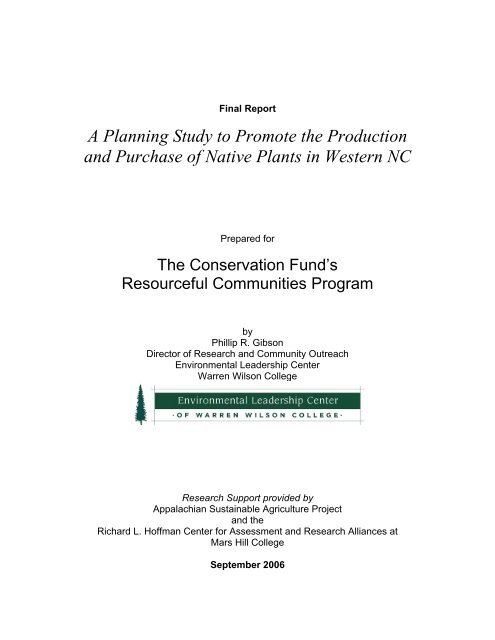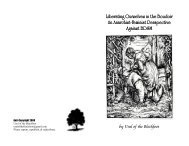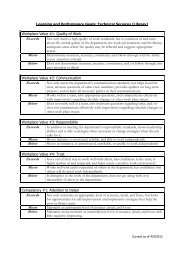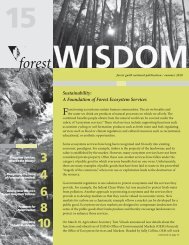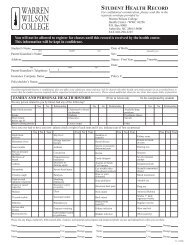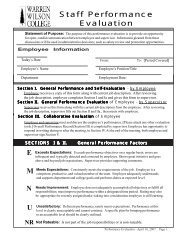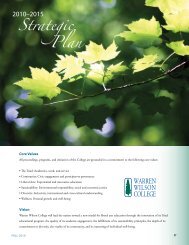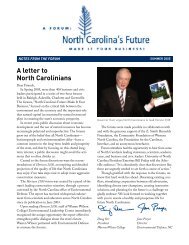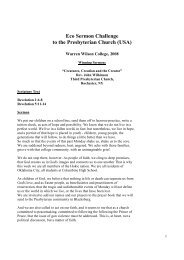A Planning Study to Promote the Production and - Warren Wilson ...
A Planning Study to Promote the Production and - Warren Wilson ...
A Planning Study to Promote the Production and - Warren Wilson ...
Create successful ePaper yourself
Turn your PDF publications into a flip-book with our unique Google optimized e-Paper software.
Final Report<br />
A <strong>Planning</strong> <strong>Study</strong> <strong>to</strong> <strong>Promote</strong> <strong>the</strong> <strong>Production</strong><br />
<strong>and</strong> Purchase of Native Plants in Western NC<br />
Prepared for<br />
The Conservation Fund’s<br />
Resourceful Communities Program<br />
by<br />
Phillip R. Gibson<br />
Direc<strong>to</strong>r of Research <strong>and</strong> Community Outreach<br />
Environmental Leadership Center<br />
<strong>Warren</strong> <strong>Wilson</strong> College<br />
Research Support provided by<br />
Appalachian Sustainable Agriculture Project<br />
<strong>and</strong> <strong>the</strong><br />
Richard L. Hoffman Center for Assessment <strong>and</strong> Research Alliances at<br />
Mars Hill College<br />
September 2006
Executive Summary<br />
The number of small family farms in western North Carolina continues <strong>to</strong> decline.<br />
The impact of this decline on <strong>the</strong> local communities includes economic stability,<br />
changes in infrastructure, loss of cultural heritage, loss of jobs, <strong>and</strong> changes in<br />
<strong>the</strong> environment.<br />
Many efforts are underway <strong>to</strong> address this decline. Most notably are <strong>the</strong> efforts<br />
<strong>to</strong> find alternative crops that improve <strong>the</strong> competitiveness <strong>and</strong> stability of <strong>the</strong><br />
farms in western North Carolina.<br />
Exotic invasive species, introduced through <strong>the</strong> nursery trade, in concert with <strong>the</strong><br />
destruction of local habitats continue <strong>to</strong> be detrimental <strong>to</strong> <strong>the</strong> biological diversity<br />
of <strong>the</strong> western North Carolina region. Natural areas such as parks, conservation<br />
areas, <strong>and</strong> o<strong>the</strong>r l<strong>and</strong> holdings work with great expense at minimizing <strong>and</strong><br />
eliminating exotic invasive plants from <strong>the</strong>ir managed area.<br />
The research discussed within this report is focused on building upon those<br />
efforts with a focus on promoting native ornamentals of western North Carolina<br />
as an alternative crop for <strong>the</strong> small local farmer of western North Carolina. This<br />
research also looks <strong>to</strong> match <strong>the</strong> needs <strong>and</strong> purchase of plants by <strong>the</strong> NC<br />
Department of Transportation with local producers of native plants of western<br />
North Carolina.<br />
Methods<br />
Person <strong>to</strong> person interviews were conducted with staff of <strong>the</strong> NC Department of<br />
Transportation <strong>and</strong> NC Department of Agriculture, <strong>the</strong> executive direc<strong>to</strong>r <strong>and</strong><br />
members of <strong>the</strong> NC Nurseryman’s Association, <strong>and</strong> <strong>the</strong> NC Secretary of<br />
Administration. A survey was also conducted <strong>the</strong> members of <strong>the</strong> Appalachian<br />
Sustainable Agriculture Project.<br />
Findings<br />
The questions for this research were could <strong>the</strong> use of native plants by NC DOT<br />
be exp<strong>and</strong>ed <strong>and</strong> what is needed <strong>to</strong> exp<strong>and</strong> <strong>the</strong> use of native plants in roadway<br />
l<strong>and</strong>scaping The North Carolina Department of Transportation utilizes native<br />
plants for both roadside beautification <strong>and</strong> post construction. Thus a dem<strong>and</strong><br />
currently exists for native ornamentals.<br />
The NC DOT has stated an interest in purchasing more locally grown native<br />
plants. The barriers <strong>to</strong> this process are:<br />
• Few contrac<strong>to</strong>rs have registered <strong>the</strong>mselves with DOT <strong>to</strong> receive<br />
“requests for bids”<br />
• Plant availability is minimal or non-existent<br />
The Value of Appalachian Grown Labeling for Nursery Growers 2
Introduction<br />
Comparing <strong>the</strong> 1949 Census data <strong>to</strong> each year following, <strong>the</strong> decline of <strong>the</strong> small<br />
family farm of western North Carolina appears <strong>to</strong> have started in <strong>the</strong> early 1950s.<br />
Of <strong>the</strong> farms that existed in <strong>the</strong> 23 mountain counties in 1949, 72 percent of <strong>the</strong>m<br />
have been converted, since <strong>the</strong>n, <strong>to</strong> o<strong>the</strong>r uses such as residential <strong>and</strong><br />
commercial development. Development is not <strong>the</strong> primary driver for l<strong>and</strong><br />
conversion but a symp<strong>to</strong>m of a number of economic, environmental <strong>and</strong> cultural<br />
pressures. It is <strong>the</strong>se three areas (economic, environmental <strong>and</strong> cultural) that<br />
are <strong>the</strong> focus of this research report <strong>and</strong> are <strong>the</strong> elements of <strong>the</strong> Conservation<br />
Fund’s Resourceful Communities “triple bot<strong>to</strong>m line”.<br />
The decline of small farms continues. In June 2006 <strong>the</strong> Asheville Citizen Times<br />
reported “approximately half of <strong>the</strong> mountains’ 4,000 [<strong>to</strong>bacco] growers have<br />
quit”. In July 2006, <strong>the</strong> Citizen Times reported a growing number of farmers who<br />
are aging out <strong>and</strong> <strong>the</strong> lack of young farmers. The declining prospect of profit<br />
from farming influences this decision. Profit is influenced by a number of<br />
variables. However, competition <strong>and</strong> dem<strong>and</strong> for <strong>the</strong> product are two of <strong>the</strong> most<br />
significant.<br />
The Environmental Leadership Center of <strong>Warren</strong> <strong>Wilson</strong> College received a<br />
$9,000 grant from The Conservation Fund’s Resourceful Communities program<br />
in order <strong>to</strong> conduct a feasibility <strong>and</strong> planning study as it relates <strong>to</strong> promoting <strong>the</strong><br />
production <strong>and</strong> purchase of native plants from small farmers of western North<br />
Carolina for roadside beautification by NC Department of Transportation.<br />
This research affirms that native plants offer an economic opportunity for western<br />
North Carolina farmers as it is a market with few competi<strong>to</strong>rs. The opportunity<br />
also exists <strong>to</strong> influence <strong>the</strong> dem<strong>and</strong> for native plants by demonstrating <strong>the</strong>ir<br />
ornamental uses <strong>to</strong> <strong>the</strong> general public. Roadside applications are viewed as one<br />
possible vehicle for marketing native ornamentals. And while this grant focused<br />
on this avenue, every public venue provides a similar opportunity.<br />
Native plants as well as small family farms are elements of <strong>the</strong> cultural <strong>and</strong> social<br />
heritage of western North Carolina. The conservation <strong>and</strong> establishment of<br />
native plant communities influence <strong>the</strong> preservation of ecological diversity.<br />
Promoting regional use of native plant species that are propagated by local small<br />
farms can enrich <strong>the</strong> biological diversity of our region, preserve <strong>the</strong> ecological<br />
heritage, <strong>and</strong> assist in minimizing <strong>the</strong> use of exotic species that tend <strong>to</strong> dominate<br />
<strong>the</strong> l<strong>and</strong>scape.<br />
The findings of this research indicate that <strong>the</strong>se opportunities are feasible <strong>and</strong><br />
are agreeable <strong>to</strong> NC Department of Transportation, western North Carolina<br />
farmers, <strong>and</strong> <strong>the</strong> supporting organizations such as Appalachian Sustainable<br />
Agriculture Project.<br />
The Value of Appalachian Grown Labeling for Nursery Growers 3
The NC DOT has a his<strong>to</strong>ry of utilizing native plants for roadside beautification<br />
<strong>and</strong> post construction. The types of species available as well as <strong>the</strong> cost <strong>and</strong><br />
access of those species guide this activity.<br />
The Value of Appalachian Grown Labeling for Nursery Growers 4
• ASAP staff consulted with a number of nursery plant growers <strong>and</strong> professionals<br />
working with farmers in <strong>the</strong> region <strong>to</strong> develop an acceptable definition of<br />
Appalachian Grown nursery plants (see below). This language is currently<br />
included in all producer agreements with farmers for Appalachian Grown<br />
Certification.<br />
APPALACHIAN GROWN PRODUCER CERTIFICATION<br />
The Appalachian Grown logo certifies farms that grow or raise food <strong>and</strong><br />
agricultural products in an Appalachian county. To become Appalachian<br />
Grown certified <strong>and</strong> market products with <strong>the</strong> Appalachian Grown logo, <strong>the</strong><br />
farm opera<strong>to</strong>r must confirm <strong>the</strong> following st<strong>and</strong>ards.<br />
1. The farm is located in an Appalachian county.<br />
2. The individual certifying <strong>the</strong> farm is <strong>the</strong> farm opera<strong>to</strong>r.<br />
3. Products marketed as Appalachian Grown will be grown or raised<br />
on <strong>the</strong> certified farm or on ano<strong>the</strong>r certified Appalachian Grown<br />
farm.<br />
4. Nursery plants <strong>and</strong> trees marketed as Appalachian Grown have<br />
spent at least 75% of life beyond propagation or at least 1 year on<br />
<strong>the</strong> farm.<br />
5. For meat marketed as Appalachian Grown, <strong>the</strong> animal spent 75% of<br />
its life after weaning on <strong>the</strong> certified farm or on ano<strong>the</strong>r certified<br />
Appalachian Grown farm.<br />
• Using direc<strong>to</strong>ries from various trade organizations <strong>and</strong> <strong>the</strong> NC Department of<br />
Agriculture <strong>and</strong> Consumer Services database, ASAP developed a list of 469 nursery<br />
growers. Nursery growers are defined here as any farm growing non-food crops<br />
included in one of four categories of plants included in <strong>the</strong> USDA Agricultural<br />
Census (Nursery s<strong>to</strong>ck crops; Nursery, floriculture, greenhouse <strong>and</strong> sod; Cut<br />
Christmas trees; <strong>and</strong> Short-rotation woody crops)<br />
• A written survey was mailed <strong>to</strong> all 469 nursery growers on <strong>the</strong> list. Where email<br />
addresses were available, a follow-up reminder was sent <strong>to</strong> nursery growers<br />
encouraging <strong>the</strong>m <strong>to</strong> participate in <strong>the</strong> survey. A <strong>to</strong>tal of 109 surveys were returned,<br />
for a response rate of 23%. Nine of those were eliminated from analysis because <strong>the</strong>y<br />
do not currently <strong>and</strong> do not plan <strong>to</strong> sell nursery products.<br />
• A list of 99 farms that indicated <strong>the</strong>y do grow nursery products meeting <strong>the</strong><br />
definition of Appalachian Grown are included in an electronic file named “Contact<br />
List for Nurseries with Appalachian Grown Plants.” For each nursery listed in <strong>the</strong><br />
file, details about which plants <strong>the</strong>y sell <strong>and</strong> which of <strong>the</strong>ir plants <strong>the</strong>y regard as<br />
native is included.<br />
• Basic analysis of data from <strong>the</strong> questionnaires is included as a separate file called<br />
“Appalachian Grown Survey Results.” The file includes frequencies <strong>and</strong> percentages<br />
from all questions on <strong>the</strong> survey, including <strong>the</strong> question of how respondents define a<br />
native plant.<br />
The Value of Appalachian Grown Labeling for Nursery Growers 5
• In exploring <strong>the</strong> definition of native plants used by nursery growers, respondents<br />
were asked how <strong>the</strong>y would define <strong>the</strong> term. 82 responses <strong>to</strong> this question were<br />
received, which can be grouped in<strong>to</strong> 7 categories as detailed below. Individual<br />
responses can be viewed on <strong>the</strong> survey results spreadsheet.<br />
How would you define a native plant<br />
Category Number %<br />
Plants that grow well/thrive in WNC 7 8.5%<br />
Plants that grow wild/naturally in WNC 25 30.5%<br />
Plants that originated in WNC 28 34.1%<br />
Plants that originated in NC 3 4.5%<br />
Plants that originated in Eastern US 2 3.7%<br />
Plants that originated in Continental US 5 6.1%<br />
Don’t know 1 6.1%<br />
O<strong>the</strong>r 6 7.3%<br />
Total 82 100%<br />
• The Local Food Guide planning team at ASAP is in <strong>the</strong> process of determining how<br />
<strong>to</strong> include nursery growers in future print editions. At least 100,000 Local Food<br />
Guides will be printed in 2007. O<strong>the</strong>r possibilities being considered for promoting<br />
locally grown nursery products include developing separate or seasonal guides or<br />
partnering with o<strong>the</strong>r organizations that produce guides <strong>to</strong> some categories of nursery<br />
products, such as <strong>the</strong> NC Christmas Tree Growers Association. The online Local<br />
Food Guide (which receives an average of 100,000 visits per year) is being adapted <strong>to</strong><br />
include a listing for Appalachian Grown certified nursery products.<br />
• A written report summarizing key findings from <strong>the</strong> survey as <strong>the</strong>y relate <strong>to</strong> ASAP’s<br />
efforts <strong>to</strong> streng<strong>the</strong>n <strong>the</strong> regional food <strong>and</strong> farm economy in western North Carolina is<br />
being prepared. A draft of that report is included as a separate file called “The Value<br />
of Appalachian Grown Labeling for Nursery Growers in WNC.” That report is<br />
owned by ASAP but is included here for <strong>the</strong> ELC <strong>to</strong> review.<br />
The Value of Appalachian Grown Labeling for Nursery Growers 6
Increasing local consumption of locally grown food <strong>and</strong> farm products has been a<br />
primary goal of <strong>the</strong> local food <strong>and</strong> farm campaign operated by <strong>the</strong> Appalachian<br />
Sustainable Agriculture Project (ASAP) since 2000. ASAP has used multiple strategies<br />
<strong>to</strong> achieve that goal, including public education <strong>and</strong> promotional work, farmer training<br />
<strong>and</strong> support, focused farm-<strong>to</strong>-school programming, <strong>and</strong> publishing <strong>and</strong> distributing <strong>the</strong><br />
Local Food Guide, a comprehensive guide <strong>to</strong> food <strong>and</strong> farms in western North Carolina.<br />
In 2006 ASAP introduced <strong>the</strong> Appalachian Grown logo for certifying farms <strong>and</strong> farm<br />
products grown or raised in Appalachian counties.<br />
In <strong>the</strong> 23-county region where ASAP operates, nearly 20% of harvested cropl<strong>and</strong> was<br />
used <strong>to</strong> grow Christmas trees <strong>and</strong> all categories of nursery crops in 2002, <strong>the</strong> most recent<br />
USDA Agricultural Census year. Approximately 20% of western North Carolina’s<br />
12,212 farms produced <strong>the</strong>se types of non-food crops that year, accounting for close <strong>to</strong><br />
32% of <strong>the</strong> $543 million cash receipts from farming in <strong>the</strong> region. Toge<strong>the</strong>r, nursery<br />
crops <strong>and</strong> cut Christmas trees generated $166.5 million in cash receipts <strong>to</strong> <strong>the</strong> region’s<br />
farmers in 2002.<br />
To explore <strong>the</strong> question of whe<strong>the</strong>r non-food crops could benefit from a local campaign<br />
similar <strong>to</strong> <strong>the</strong> one used for promoting locally grown food, ASAP commissioned a survey<br />
of all farms producing nursery crops in <strong>the</strong> region during <strong>the</strong> summer of 2006. The goals<br />
of <strong>the</strong> survey were <strong>to</strong> explore <strong>the</strong> applicability of <strong>the</strong> Appalachian Grown designation<br />
for trees, shrubs <strong>and</strong> plants grown in <strong>the</strong> region, <strong>and</strong> <strong>to</strong> explore interest among producers<br />
of <strong>the</strong>se crops in using such a label.<br />
For <strong>the</strong> survey, a list of farmers growing Christmas trees <strong>and</strong> all categories of plants was<br />
compiled using direc<strong>to</strong>ries from various trade organizations <strong>and</strong> from <strong>the</strong> North Carolina<br />
Department of Agriculture <strong>and</strong> Consumer Services database. A <strong>to</strong>tal of 469 growers<br />
were identified <strong>and</strong> mailed a written survey asking about <strong>the</strong> products <strong>the</strong>y grow <strong>and</strong><br />
issues related <strong>to</strong> using <strong>the</strong> Appalachian Grown label. 109 surveys were returned for a<br />
response rate of 23%. Results from 100 usable surveys are presented below.<br />
Descriptive information<br />
The term nursery growers is used in this survey <strong>to</strong> mean any farm growing non-food<br />
crops included in any of four categories of plants in <strong>the</strong> USDA Agricultural Census<br />
(Nursery s<strong>to</strong>ck crops; Nursery, greenhouse, floriculture <strong>and</strong> sod; Cut Christmas trees; <strong>and</strong><br />
Short-rotation woody crops). Specific items grown by <strong>the</strong> farms surveyed here are listed<br />
in Figure 1, as are summary statistics regarding acreage used for growing nursery crops.<br />
The Value of Appalachian Grown Labeling for Nursery Growers 7
Figure 1: Nursery Crops Grown by Survey Respondents<br />
(n=100)<br />
Foliage plants<br />
O<strong>the</strong>r<br />
Short-rotation<br />
woody crops<br />
Nursery s<strong>to</strong>ck<br />
Cut Xmas trees<br />
Herbaceous<br />
perennials<br />
Total Acres: 5427 Average Acreage: 54.3<br />
Median Acreage: 5 Range: .10 <strong>to</strong> 1170 acres<br />
More than half of all farms surveyed raise plants on fewer than 5 acres, which is not<br />
surprising given <strong>the</strong> small size of WNC farms in general. Only three farms responding <strong>to</strong><br />
<strong>the</strong> survey were large, each of those operating on 1000 or more acres.<br />
Nearly a third of <strong>the</strong> nursery growers reported that <strong>the</strong>y also grow o<strong>the</strong>r types of farm<br />
products (see Figure 2). Non-nursery crops grown by <strong>the</strong>se farms included timber <strong>and</strong><br />
pulpwood as well as small quantities of food crops. Food production mainly included<br />
fruits <strong>and</strong> vegetables grown for home consumption or for direct sale <strong>to</strong> consumers.<br />
Figure 2: Non-Nursery Products Reported by Survey<br />
Respondents (n=34)<br />
Animals<br />
(Cattle/goats)<br />
O<strong>the</strong>r<br />
Vegetables<br />
Herbs<br />
O<strong>the</strong>r Greenery<br />
Hay<br />
Fruit<br />
Timber/Pulpwood<br />
Total Acres for non-nursery crops: 2690 Average acreage: 79<br />
Median Acreage: 15 Range: 1 <strong>to</strong> 1000<br />
The Value of Appalachian Grown Labeling for Nursery Growers 8
Determining <strong>the</strong> Value of a Local Label for Nursery Products<br />
In order for Appalachian Grown or ano<strong>the</strong>r similar label <strong>to</strong> be useful for nursery<br />
products grown in <strong>the</strong> region, several conditions must be met. First, <strong>the</strong>re must be a<br />
sufficient quantity of products that meet an accepted definition of locally grown. There<br />
must also be interest among growers in using <strong>the</strong> label. And <strong>the</strong>re must be markets where<br />
<strong>the</strong> label adds value <strong>to</strong> <strong>the</strong> products being sold. Survey results related <strong>to</strong> each of those<br />
areas will be discussed below.<br />
Definition of Appalachian Grown<br />
In consultation with farmers <strong>and</strong> professionals working with farmers throughout western<br />
North Carolina, ASAP developed a set of criteria for Appalachian Grown certification<br />
which includes a definition of nursery plants <strong>and</strong> trees (see Figure 3).<br />
Figure 3. Producer Certification for Appalachian Grown Farms <strong>and</strong> Farm Products<br />
To become Appalachian Grown certified <strong>and</strong> market products with <strong>the</strong> Appalachian<br />
Grown logo, <strong>the</strong> farm opera<strong>to</strong>r must confirm <strong>the</strong> following st<strong>and</strong>ards.<br />
1. The farm is located in an Appalachian county.<br />
2. The individual certifying <strong>the</strong> farm is <strong>the</strong> farm opera<strong>to</strong>r.<br />
3. Products marketed as Appalachian Grown will be grown or raised on <strong>the</strong> certified<br />
farm or on ano<strong>the</strong>r certified Appalachian Grown farm.<br />
4. Nursery plants <strong>and</strong> trees marketed as Appalachian Grown have spent at least<br />
75% of life beyond propagation or at least 1 year on <strong>the</strong> farm.<br />
5. For meat marketed as Appalachian Grown, <strong>the</strong> animal spent 75% of its life after<br />
weaning on <strong>the</strong> certified farm or on ano<strong>the</strong>r certified Appalachian Grown farm.<br />
Of 100 survey respondents, more than two thirds indicated that at least 90% of <strong>the</strong>ir<br />
products would meet <strong>the</strong> proposed definition of Appalachian Grown nursery products.<br />
Only one indicated that none of its products would meet <strong>the</strong> definition.<br />
Interest among growers<br />
Interest is high among this group of growers in pursuing Appalachian Grown labeling<br />
<strong>and</strong> advertising. More than 60% of respondents indicated that <strong>the</strong>y would like <strong>to</strong> be<br />
contacted about Appalachian Grown labeling <strong>and</strong>/or being listed in ASAP’s Local<br />
Food Guide. And nearly 70% said <strong>the</strong>y thought sales of nursery products would benefit<br />
from Appalachian Grown labeling <strong>and</strong> advertising. Of 34 responses <strong>to</strong> a question<br />
asking for comments about <strong>the</strong> label, close <strong>to</strong> one quarter were positive <strong>and</strong> ei<strong>the</strong>r<br />
directly or indirectly signaled support for <strong>the</strong> new logo.<br />
The Value of Appalachian Grown Labeling for Nursery Growers 9
Markets <strong>and</strong> Value of <strong>the</strong> Label<br />
At a minimum, a local label is valuable if it results in increased product sales. While a<br />
significant number of nursery growers expressed doubts about <strong>the</strong> ability of <strong>the</strong><br />
Appalachian Grown label <strong>to</strong> materially benefit <strong>the</strong>ir businesses, most still indicated<br />
that nursery product sales could benefit from this type of advertising. From a<br />
sustainability perspective, however, <strong>the</strong> highest value for a local label is when use of <strong>the</strong><br />
label results in increased sales in <strong>the</strong> region where <strong>the</strong> products were grown.<br />
A sustainable farming system is one that provides incentives for farmers <strong>to</strong> stay in<br />
farming <strong>and</strong> maximizes returns from farming – <strong>to</strong> individual farmers as well as <strong>to</strong> <strong>the</strong><br />
region where <strong>the</strong>y farm – while minimizing social, environmental <strong>and</strong> financial costs of<br />
farming. For example, local markets can allow farmers <strong>to</strong> earn greater returns by<br />
minimizing product transport costs <strong>and</strong> payments <strong>to</strong> intermediaries. They also provide<br />
additional economic impact <strong>to</strong> <strong>the</strong> region by keeping dollars spent on farm products<br />
circulating within <strong>the</strong> local area.<br />
Currently, 57% of nursery growers completing a survey sell <strong>to</strong> retailers or wholesalers<br />
within <strong>the</strong> region <strong>and</strong> 61% sell <strong>to</strong> retailers <strong>and</strong> wholesalers in o<strong>the</strong>r regions. When asked<br />
about <strong>the</strong>ir interest in exp<strong>and</strong>ing sales <strong>to</strong> local markets, more than 70% of respondents<br />
scored <strong>the</strong>ir interest as 8 or higher on a scale from 1 <strong>to</strong> 10. However, three areas of<br />
concern were identified as barriers <strong>to</strong> achieving a higher volume of local sales.<br />
The first two concerns focused on consumer awareness <strong>and</strong> avenues for selling nursery<br />
products locally. ASAP is well-positioned <strong>to</strong> address <strong>the</strong>se concerns by incorporating<br />
nursery growers <strong>and</strong> nursery products in<strong>to</strong> its existing local food campaign. That<br />
campaign is at least partly responsible for high dem<strong>and</strong> for local food in <strong>the</strong> region.<br />
ASAP has distributed more than 250,000 Local Food Guides over <strong>the</strong> last six years <strong>and</strong><br />
implemented many o<strong>the</strong>r awareness-raising initiatives. ASAP has also worked with local<br />
farmers <strong>to</strong> increase <strong>the</strong> number of farmers’ markets in <strong>the</strong> region.<br />
The third area of concern described by nursery growers is more problematic. Of 77<br />
responses <strong>to</strong> a question about barriers <strong>to</strong> increasing local sales of nursery products, more<br />
than 45% named issues related <strong>to</strong> <strong>the</strong> mismatch between supply <strong>and</strong> dem<strong>and</strong> for nursery<br />
products in western North Carolina. References <strong>to</strong> competition from so-called “big box<br />
retailers” fit within this category, as did numerous references <strong>to</strong> price <strong>and</strong> competition<br />
from o<strong>the</strong>r local growers <strong>and</strong> comments like “oversupply” <strong>and</strong> “low dem<strong>and</strong>.” The<br />
growers described a situation where local dem<strong>and</strong> or consumption of nursery products<br />
lags far behind <strong>the</strong> level of supply. Interestingly, this is in direct contrast <strong>to</strong> <strong>the</strong> situation<br />
with food crops, where <strong>the</strong> market for locally grown fruits <strong>and</strong> vegetables far exceeds <strong>the</strong><br />
supply of locally grown fruits <strong>and</strong> vegetables. 1<br />
1 See The Western North Carolina Food <strong>and</strong> Farm Economy at www.asapconnections.org under <strong>the</strong><br />
heading Food Systems Research.<br />
The Value of Appalachian Grown Labeling for Nursery Growers 10
Conclusions <strong>and</strong> Implications<br />
The data suggest a need <strong>to</strong> differentiate locally grown nursery products in an effort <strong>to</strong><br />
increase local dem<strong>and</strong> for <strong>the</strong> products. Nursery growers enrolling in <strong>the</strong> Appalachian<br />
Grown logo program may be one way <strong>to</strong> accomplish this. Use of <strong>the</strong> logo as one<br />
component of a comprehensive local food campaign has been effective in increasing local<br />
dem<strong>and</strong> for locally grown fruits <strong>and</strong> vegetables.<br />
In <strong>the</strong> short term, it will require minimal investment of time <strong>and</strong> resources for ASAP <strong>to</strong><br />
exp<strong>and</strong> its local food campaign <strong>to</strong> include nursery products. Opportunities range from<br />
adding a category for nursery products <strong>to</strong> <strong>the</strong> online version of <strong>the</strong> Local Food Guide <strong>to</strong><br />
adding a section for nursery products in <strong>the</strong> print version of <strong>the</strong> guide <strong>to</strong> developing an all<br />
new guide for nursery products <strong>to</strong> be sent out through existing distribution channels. As<br />
for markets, <strong>the</strong>re exist opportunities <strong>to</strong> include nursery products in any of <strong>the</strong> nearly<br />
three dozen markets currently affiliated with ASAP’s campaign.<br />
Longer term, it may also be reasonable for nursery growers who are interested in<br />
exp<strong>and</strong>ing sales <strong>to</strong> local markets <strong>to</strong> consider shifting <strong>to</strong> production of fruits <strong>and</strong><br />
vegetables. The high level of dem<strong>and</strong> for those products, which is likely <strong>to</strong> continue<br />
growing as ASAP streng<strong>the</strong>ns <strong>and</strong> exp<strong>and</strong>s its campaign more fully in<strong>to</strong> <strong>the</strong> 23-county<br />
region of western North Carolina, can protect against situations where prices are driven<br />
down below <strong>the</strong> level of profitability. These types of shifts will of course depend on<br />
grower interest; on climate, soil <strong>and</strong> wea<strong>the</strong>r conditions dictating what crops can<br />
realistically be grown in <strong>the</strong> region; <strong>and</strong> on investments of time <strong>and</strong> training required <strong>to</strong><br />
make <strong>the</strong>m.<br />
The Value of Appalachian Grown Labeling for Nursery Growers 11
The Value of Appalachian Grown Labeling for Nursery Growers 12
Introduction<br />
The Environmental Leadership Center of <strong>Warren</strong>-<strong>Wilson</strong> College received a<br />
$9,000 grant from <strong>the</strong> Conservation Fund of North Carolina in order <strong>to</strong> investigate<br />
how enhance<br />
contracted with <strong>the</strong> Richard L. Hoffman Center for Assessment <strong>and</strong> Research<br />
Alliances (CARA) at Mars Hill College <strong>to</strong> conduct an analysis of purchase <strong>and</strong><br />
use of native plants by <strong>the</strong> North Carolina Department of Transportation (DOT).<br />
Specifically, CARA agreed <strong>to</strong>: 1) Research current DOT policies <strong>and</strong> practices<br />
regarding procurement of plant species; 2) review local <strong>and</strong> regional plant<br />
species available for commercial l<strong>and</strong>scape application; 3) review existing<br />
commercial infrastructure that can supply native plants <strong>to</strong> DOT, <strong>and</strong>; 4) make<br />
recommendations for specific short-term <strong>and</strong> long-term strategies <strong>to</strong> develop<br />
commercial production <strong>and</strong> distribution infrastructure for using native plants in<br />
DOT roadside beautification or construction remediation projects.<br />
In <strong>the</strong> course of this work researchers interviewed<br />
• DOT l<strong>and</strong>scape engineers<br />
• The Roadside Environmental Unit at DOT headquarters in Raleigh<br />
• The North Carolina Secretary of Administration who oversees <strong>the</strong> state Purchase<br />
<strong>and</strong> Contracts Office<br />
• Western North Carolina l<strong>and</strong>scape companies<br />
• Western North Carolina farmers<br />
• The Executive Direc<strong>to</strong>r of <strong>the</strong> North Carolina Nurserymen’s Association, <strong>and</strong><br />
• Region 14 DOT<br />
Some of our findings from information ga<strong>the</strong>red are as follows:<br />
1) DOT officials are generally supportive of increased use of native plant species in<br />
roadside beautification <strong>and</strong> construction remediation efforts. They welcome<br />
collaboration on pilot projects <strong>and</strong> educational efforts <strong>to</strong> increase participation by<br />
native plant growers in <strong>the</strong> purchasing <strong>and</strong> contract bidding process. A<br />
substantial amount of decision-making authority is delegated <strong>to</strong> regional division<br />
officials <strong>and</strong> DOT Board Members who take interest in particular projects.<br />
2) The DOT Purchase <strong>and</strong> Contract bidding process is cumbersome, multi-layered,<br />
<strong>and</strong> difficult <strong>to</strong> underst<strong>and</strong>. Bids probably cannot specify that a given desired<br />
plant species must be supplied from with-in <strong>the</strong> state of North Carolina, due <strong>to</strong><br />
Federal inter-state commerce laws. Though cost considerations are paramount in<br />
most bids, specifications on plant types <strong>and</strong> <strong>the</strong>ir qualities can be decisive.<br />
3) Very few western North Carolina plant companies are registered <strong>to</strong> do business<br />
with <strong>the</strong> state. Of 170 companies that are registered with state government <strong>to</strong> sell<br />
nursery s<strong>to</strong>ck, equipment, <strong>and</strong> supplies, 15 are located in western North<br />
Carolina. Among those 15, approximately 5 sell plants.<br />
Based on <strong>the</strong> above key findings, recommendations for fur<strong>the</strong>r action include:<br />
1) Develop a viable pilot project <strong>to</strong> introduce <strong>and</strong> publicly<br />
highlight <strong>the</strong> use of western North Carolina native plants by <strong>the</strong><br />
state. Such a project will require collaboration among state<br />
officials, local nurseries, local municipalities, nonprofits, <strong>and</strong><br />
<strong>the</strong> WWC Center for Environmental Leadership.<br />
The Value of Appalachian Grown Labeling for Nursery Growers 13
2) Develop an educational <strong>and</strong> outreach program <strong>to</strong> western<br />
North Carolina nurseries <strong>and</strong> native l<strong>and</strong>scaping companies<br />
on how <strong>to</strong> participate in bids for DOT projects.<br />
3) Work with organizations such as <strong>the</strong> Appalachian Sustainable<br />
Agriculture Project (ASAP), <strong>and</strong> <strong>the</strong> North Carolina<br />
Cooperative Extension Service, <strong>to</strong> develop a certification<br />
process for defining specific plants as “native.”<br />
The Value of Appalachian Grown Labeling for Nursery Growers 14
DOT Procurement of Plant Materials<br />
North Carolina’s state government has a well-established system of purchasing from<br />
outside vendors. Its primary responsibility appears <strong>to</strong> be good stewardship of <strong>the</strong> state’s<br />
resources, <strong>and</strong> as such, price of materials or services is <strong>the</strong> overriding consideration in<br />
<strong>the</strong> vast amount of purchases.<br />
Courts have ruled that federal law, particularly <strong>the</strong> Interstate Commerce Clause of <strong>the</strong><br />
US Constitution, prohibits restricting purchases <strong>to</strong> vendors located in a particular state or<br />
states. Therefore, various state policies on purchasing material or services from North<br />
Carolina-based suppliers are essentially unenforceable. As a result, a significant portion<br />
of plants materials purchased by DOT are from suppliers located in <strong>the</strong> Midwest.<br />
In North Carolina, DOT operates under <strong>the</strong> guidelines of both <strong>the</strong> Department's<br />
Purchasing Section (http://www.ncdot.org/business/) <strong>and</strong> <strong>the</strong> guidelines of The State<br />
Department of Purchase <strong>and</strong> Contracts (P&C) (http://www.doa.state.nc.us/P<strong>and</strong>C/).<br />
Please see <strong>the</strong>ir web pages regarding specific details.<br />
Purchasing Overview<br />
All North Carolina Government purchasing programs use competitive bidding. The<br />
Purchasing Unit of DOT reports <strong>to</strong> <strong>the</strong> Department’s Chief Financial Officer. The<br />
Purchasing Unit has <strong>the</strong> authority <strong>and</strong> responsibility of obtaining all commodities<br />
necessary for <strong>the</strong> operation <strong>and</strong> maintenance of <strong>the</strong> department of transportation. By<br />
having a purchasing section, <strong>the</strong> department can obtain more favorable pricing on all<br />
commodities meeting <strong>the</strong> department’s specifications <strong>and</strong> thus use available funding<br />
more efficiently. This section has <strong>to</strong> be especially careful <strong>to</strong> obtain public pricing without<br />
favoritism.<br />
For purchases in excess of $25,000, bids must be submitted through <strong>the</strong> North Carolina<br />
Department of Administration Purchase <strong>and</strong> Contracts Division (P&C). The state<br />
purchasing officer has authorized a dollar limit of $25,000 <strong>to</strong> <strong>the</strong> DOT for purchasing of<br />
commodities, printing, <strong>and</strong> services without using <strong>the</strong> competitive bidding process. All<br />
commodities <strong>and</strong> contractual services covered by term contracts must be purchased in<br />
accordance with <strong>the</strong> instructions of those contracts. The purchasing officer of <strong>the</strong> DOT<br />
sets forth written purchasing procedures for making small purchases. It is not<br />
permissible <strong>to</strong> divide purchases <strong>to</strong> avoid <strong>the</strong> normal bid process. Awarding of contracts<br />
which are under $25,000 is <strong>the</strong> responsibility of DOT <strong>and</strong> does not come under P&C.<br />
The purchasing policies for different dollar amounts are as follows:<br />
Table 1: Purchasing Requirements by Dollar Amount<br />
PURCHASES MINIMUM REQUIREMENTS<br />
0 <strong>to</strong> $2,500.00 COMPETITION NOT REQUIRED<br />
$2,500.00 <strong>to</strong><br />
$5,000.00<br />
$5,000.00 <strong>to</strong><br />
$25,000.00<br />
THREE TELEPHONE OR WRITTEN QUOTE<br />
OR DOCUMENT REASON(S) FOR NOT<br />
RECEIVED 3 QUOTES.<br />
PREPARE RFQ DOCUMENTS AND<br />
ADVERTISE THROUGH IPS, (INTERACTIVE<br />
PURCHASING SYSTEM).<br />
$25,000.00 AND PREPARE BID PACKAGE AND FORWARD<br />
WRITTEN QUOTE<br />
REQUIRED FROM<br />
WINNER<br />
The Value of Appalachian Grown Labeling for Nursery Growers 15
UP<br />
TO PURCHASE AND CONTRACT.<br />
Informal Bid Process<br />
Normally, <strong>the</strong>re are two types of informal bids, telephones solicitations <strong>and</strong> written<br />
solicitations. Division engineers, branch managers, section heads, unit heads, or <strong>the</strong>ir<br />
design agents may secure informal quotations from suppliers. The quotation form found<br />
in <strong>the</strong> purchasing web site must be used due <strong>to</strong> terms <strong>and</strong> conditions which are required.<br />
This form can be downloaded <strong>and</strong> modified <strong>to</strong> include description of all requirements <strong>and</strong><br />
<strong>the</strong> specifications.<br />
St<strong>and</strong>ard DOT Purchasing Practices<br />
NCDOT is divided in<strong>to</strong> 14 local division offices under <strong>the</strong> Division of Highways located<br />
geographically throughout <strong>the</strong> state. These 14 local division offices are responsible for<br />
construction, maintenance, roadside environmental programs, traffic services <strong>and</strong> <strong>the</strong><br />
fiscal <strong>and</strong> facility operations involved in administering <strong>the</strong>se functions. These Divisions<br />
enjoy a relatively high degree of au<strong>to</strong>nomy in administering <strong>and</strong> executing specific<br />
projects within <strong>the</strong>ir allocated budgets.<br />
Once a Division determines that <strong>the</strong>y have a need for an enhancement planting project<br />
<strong>and</strong> monies are ear-marked for <strong>the</strong> project, <strong>the</strong> Division will contact <strong>the</strong> Design <strong>and</strong><br />
Development Section in <strong>the</strong> Central Unit in Raleigh. This Section <strong>the</strong>n works with <strong>the</strong><br />
Division <strong>to</strong> design an appropriate plan for <strong>the</strong> site. Once <strong>the</strong> plan is finalized, <strong>the</strong><br />
Division 'lets' <strong>the</strong> project for bid through ei<strong>the</strong>r DOT Purchasing or P&C. Interested<br />
vendors <strong>the</strong>n locate <strong>the</strong> plant material <strong>and</strong> price <strong>the</strong> job. Multiple vendors bid each job<br />
<strong>and</strong> as a result of <strong>the</strong>ir bids, <strong>the</strong> project is awarded <strong>to</strong> <strong>the</strong> lowest priced competent<br />
vendor. Once <strong>the</strong> successful vendor is ready <strong>to</strong> buy plant material, DOT’s statewide<br />
plant inspec<strong>to</strong>r visits <strong>the</strong> nurseries <strong>and</strong> tags <strong>the</strong> material for <strong>the</strong> project. The vendor <strong>the</strong>n<br />
works under <strong>the</strong> supervision of Division staff <strong>to</strong> perform <strong>the</strong> installation. Once <strong>the</strong><br />
contract is completed, future maintenance becomes <strong>the</strong> Division's responsibility.<br />
In most cases, especially for projects exceeding several tens of thous<strong>and</strong>s of dollars,<br />
vendors for enhancement planting projects are general contrac<strong>to</strong>rs who engage subcontrac<strong>to</strong>rs<br />
such as nurseries <strong>and</strong> l<strong>and</strong>scapers <strong>to</strong> h<strong>and</strong>le specific components of <strong>the</strong><br />
given job. In order <strong>to</strong> successfully participate in large projects, plant material suppliers<br />
will probably need <strong>to</strong> establish close working relationships with established vendors.<br />
Bidding for DOT work would be submitted by <strong>the</strong> vendor after receiving quotes from <strong>the</strong><br />
plant material supplier.<br />
The following table exemplifies a typical process “flow” for implementation of contracted<br />
projects:<br />
The Value of Appalachian Grown Labeling for Nursery Growers 16
Table 2: DOT Project Implementation Flowchart<br />
Becoming a Vendor<br />
Registering as a vendor with <strong>the</strong> state is required for any nurseries or o<strong>the</strong>r purveyors of<br />
plant material who wish <strong>to</strong> sell <strong>to</strong> DOT. The process of registering as a vendor, vetting<br />
The Value of Appalachian Grown Labeling for Nursery Growers 17
projects for bid, filing a formal bid, <strong>and</strong> executing terms of a contract are time-consuming<br />
<strong>and</strong> require significant attention <strong>to</strong> detail.<br />
P&C has a step-by-step online guide <strong>to</strong> registering as a vendor located at<br />
http://www.doa.state.nc.us/P<strong>and</strong>C/OnlineEducation/VL/VLRegistration/index.html.<br />
The Following section is taken from <strong>the</strong> Interactive Purchasing Website<br />
http://www.ips.state.nc.us/ips/vendor/vndpubmain.asp<br />
“The Vendor Registration System is self-administered with a review by a specialist within<br />
<strong>the</strong> Division of Purchase <strong>and</strong> Contract. You are responsible for <strong>the</strong> content of your file<br />
<strong>and</strong> any subsequent updates. Failure <strong>to</strong> enter all of <strong>the</strong> m<strong>and</strong>a<strong>to</strong>ry information will not<br />
enable us <strong>to</strong> post your vendor file on <strong>the</strong> Internet. Likewise it is important that all<br />
information is entered correctly. If, for example, you enter an incorrect e-mail address,<br />
we will call you <strong>to</strong> tell you that <strong>the</strong> e-mail was returned. If <strong>the</strong> phone number is also<br />
incorrect, your information shall be deleted.”<br />
“Being a registered vendor does NOT guarantee <strong>the</strong> receipt of electronic notification for<br />
all applicable solicitations. Vendors must routinely check our IPS Bids site for a listing of<br />
current business opportunities from <strong>the</strong> Division of Purchase <strong>and</strong> Contract <strong>and</strong> o<strong>the</strong>r<br />
agencies required <strong>to</strong> post certain solicitations <strong>to</strong> this system. The Division of Purchase<br />
<strong>and</strong> Contract shall not be responsible if a vendor does not receive an electronic<br />
notification for any particular solicitation. This notification is provided as a convenience<br />
only. The Division of Purchase <strong>and</strong> Contract nei<strong>the</strong>r accepts nor assumes responsibility<br />
for electronic notification under all circumstances.”<br />
Commodity Codes<br />
P&C tracks bids <strong>and</strong> purchases by specific five-digit commodity codes. The first three<br />
digits of a code indicate <strong>the</strong> material’s general category. For plant materials <strong>the</strong> most<br />
significant general codes are 595- Nursery S<strong>to</strong>ck, Equipment, <strong>and</strong> Supplies, <strong>and</strong> 790-<br />
Seed, Sod, Soil <strong>and</strong> Inoculants. Specific subcategories are listed below:<br />
Table 3: Commodity Codes 595 <strong>and</strong> 790<br />
CLASS ITEM<br />
DESCRIPTION<br />
595 00 NURSERY STOCK, EQUIPMENT, AND SUPPLIES<br />
595 10 Bedding Plants <strong>and</strong> Cuttings<br />
595 15 Bulbs <strong>and</strong> Seeds<br />
595 26 Edging, Lawn<br />
595 28 Flowers, Fresh<br />
595 30 Fountains, Statues <strong>and</strong> O<strong>the</strong>r Decorative Lawn <strong>and</strong> Garden Items<br />
595 33 Grates, Guards, <strong>and</strong> O<strong>the</strong>r Protective Devices For Trees <strong>and</strong> Shrubs<br />
595 35 Groundcovers <strong>and</strong> Vines<br />
595 37 Horticultural Specialties incl. Ornamental Floriculture Products<br />
595 40 Nursery, Greenhouse <strong>and</strong> Floral Supplies: Labels, Planters, Pots, Tags,<br />
The Value of Appalachian Grown Labeling for Nursery Growers 18
Trellises, etc.<br />
595 50 Peat Moss<br />
595 52 Perennials<br />
595 55 Plant Foods (Not Fertilizer)<br />
595 58 Plant Shine<br />
595 60<br />
595 61 Plants, Indoor<br />
Plant Sprayers <strong>and</strong> Respira<strong>to</strong>rs, Plant Propagation Mats, etc., <strong>and</strong><br />
Accessories<br />
595 62 Recycled Nursery Equipment <strong>and</strong> Accessories<br />
595 63 Rocks, Ornamental <strong>and</strong> Decorative<br />
595 65 Shrubbery, Evergreen<br />
595 66 Shrubbery, Flowering<br />
595 70 Trees, Fruit <strong>and</strong> Nut<br />
595 75 Trees, Ornamental <strong>and</strong> Shade<br />
595 77 Tropicals<br />
595 80 Turf Blankets, Seeded (Including Recycled)<br />
595 88 Vases, Flower Pots, Pottery, etc.<br />
595 90 Vermiculite <strong>and</strong> Perlite<br />
595 95 Wood Chips <strong>and</strong> Bark: Composted, Shredded, Etc.<br />
CLASS ITEM<br />
DESCRIPTION<br />
790 00 SEED, SOD, SOIL, AND INOCULANTS<br />
790 02 Athletic Field Compositions (Baseball Infields, etc.)<br />
790 05 Desert Plant Seed<br />
790 10 Field Seed: Cot<strong>to</strong>n, etc.<br />
790 15 Field Seed: Grains, etc.<br />
790 20 Grass Seed<br />
790 30 Inoculants<br />
790 34 Seed Peanuts<br />
790 37 Rice Seed<br />
790 40 Seed Pota<strong>to</strong>es<br />
790 50 Sod, Grass<br />
790 54 Soil Mixtures (Special)<br />
The Value of Appalachian Grown Labeling for Nursery Growers 19
790 60 Sprigs, Grass<br />
790 70 Top Soil <strong>and</strong> Fill Dirt (For Mulch See Class 335)<br />
790 73 Tree Seeds<br />
790 80 Vegetable Seed<br />
790 95 Recycled<br />
Above listings are taken from <strong>the</strong> P&C website<br />
DOT Use of Native Plant Materials<br />
As noted in <strong>the</strong> section above, DOT does make use of native plant materials in many of<br />
its projects. The Fifteen geographic divisions within DOT enjoy a high degree of<br />
au<strong>to</strong>nomy in determining specifications for materials <strong>to</strong> be purchased for specific<br />
projects within <strong>the</strong>ir divisions.<br />
DOT reports that in fiscal year 2005, just under $1.7 million of plant materials were<br />
purchased through both <strong>the</strong> Department’s Purchasing Unit <strong>and</strong> P&C. A review of <strong>the</strong><br />
data provided indicates that not more than $340,000 of <strong>the</strong> <strong>to</strong>tal purchases can have<br />
been for native plants provided by in-state vendors. This figure may not include plant<br />
materials that were subsumed in large remediation contracts that were awarded <strong>to</strong><br />
general contrac<strong>to</strong>rs. Of <strong>the</strong> amount reported, nearly $1.4 million was purchased from instate<br />
vendors. However, one-half of <strong>the</strong> <strong>to</strong>tal purchases were for turf grass that was in<br />
fact grown out of state but sold by in-state vendors.<br />
Table 4: NCDOT Comparison of Plant Material Purchased In-State vs. Out-of-State,<br />
Fiscal 2005<br />
EXPENDITURE<br />
VENDOR LOCATIONS TOTAL $<br />
DESCRIPTIO<br />
N<br />
IN STATE %<br />
OUT OF STATE<br />
%<br />
Plant Material:<br />
Ornamentals,<br />
Trees <strong>and</strong><br />
Shrubs<br />
Daylilies<br />
Seed:<br />
Turfgrass<br />
Daylilies sent<br />
<strong>to</strong> Caledonia<br />
State Prison<br />
Farm <strong>to</strong> grow<br />
for NCDOT<br />
Grown<br />
outside of NC<br />
but sold by instate<br />
vendors;<br />
Used for<br />
Erosion<br />
Control<br />
$421,027<br />
(100%)<br />
$66,808<br />
(50%)<br />
$838,583<br />
(100%)<br />
$421,027<br />
$66,930 (50%) $133,738<br />
$838,583<br />
The Value of Appalachian Grown Labeling for Nursery Growers 20
Wildflowers<br />
(Native <strong>and</strong><br />
Non-native)<br />
Native<br />
Grasses<br />
Does not<br />
include <strong>the</strong><br />
native<br />
wildflowers<br />
we grow <strong>to</strong><br />
plant on ROW<br />
Statewide<br />
$180,427 (100%) $180,427<br />
$6,170 (22%) 21,587 (78%) $27,757<br />
Wetl<strong>and</strong><br />
Mitigation:<br />
Live stakes,<br />
3-gallon trees,<br />
Marsh<br />
grasses,<br />
Bare-root tree<br />
seedlings<br />
$52,586<br />
(68%)<br />
$24,504 (32%) $77,090<br />
TOTAL $1,385,174 $293,448 $1,678,622<br />
(82.5%) (17.5%)<br />
These expenditures represent NCDOT direct purchases thru low-bid solicitation through<br />
DOT’s Purchasing Unit <strong>and</strong> NCDOA’s Division of Purchase <strong>and</strong> Contract.<br />
Interviews with Division Roadside Environmental Engineers<br />
Project researcher Bryan Freeborn conducted telephone <strong>and</strong> email interviews with three<br />
roadside environmental engineers at different divisions in DOT, concerning use of plant<br />
materials in <strong>the</strong>ir work. Responses are recorded in <strong>the</strong> following table<br />
Table 5: Responses <strong>to</strong> Interviews with Roadside Environmental Engineers<br />
Question for<br />
Division Roadside<br />
Engineers Division 14 Central Unit/Raleigh Division 3<br />
What % of plants<br />
<strong>and</strong> trees that you<br />
use in roadside<br />
projects<br />
perennial<br />
are<br />
What % of plants<br />
<strong>and</strong> trees that you<br />
use in roadside<br />
projects are<br />
annual<br />
All except some<br />
wildflowers<br />
(cosmos,<br />
poppy, catchfly)<br />
Some<br />
wildflowers<br />
noted above<br />
Enhancement Projects are 100%<br />
perennial plants <strong>and</strong> trees.<br />
We, typically, only purchase annual<br />
plant material for special event<br />
projects. For example, we purchased<br />
approximately 50,000 annual bedding<br />
plants for <strong>the</strong> 2005 US Open in<br />
Pinehurst.<br />
Probably<br />
around 75 <strong>to</strong><br />
80 % are<br />
perennial.<br />
20 <strong>to</strong> 25%<br />
annual.<br />
The Value of Appalachian Grown Labeling for Nursery Growers 21
What plants <strong>and</strong><br />
trees have you<br />
seen that do well in<br />
roadside projects<br />
for your division<br />
What are <strong>the</strong> pros<br />
<strong>and</strong> cons of<br />
flowers vs. trees in<br />
roadside projects<br />
Are <strong>the</strong>re fac<strong>to</strong>rs<br />
that would<br />
encourage native<br />
or regional plants<br />
in roadside<br />
projects<br />
What native or<br />
regional plants are<br />
you aware of being<br />
used now in<br />
roadside projects<br />
Most all species<br />
with <strong>the</strong><br />
exception of a<br />
few depending<br />
on <strong>the</strong> site<br />
Trees are more<br />
sustainable<br />
while flowers<br />
offer more<br />
immediate<br />
impact<br />
Location <strong>and</strong><br />
whe<strong>the</strong>r it be<br />
formal or not<br />
Deciduous<br />
hollies, clethra,<br />
itea, azalea,<br />
rhododendron,<br />
dogwood,<br />
maple, oak,<br />
redbud,<br />
inkberry holly,<br />
leucothoe, river<br />
birch<br />
Our designers <strong>and</strong> division personnel<br />
are mindful that soil types, specific<br />
project needs, <strong>and</strong> climatic conditions<br />
play a role in plant selection. Plant<br />
selection is based on what works<br />
best based in <strong>the</strong> regional<br />
conditions. For instance, Ole<strong>and</strong>er<br />
works well in specific coastal areas<br />
but is unsuccessful just a few miles<br />
inl<strong>and</strong>.<br />
Annual bedding plants are used<br />
where <strong>the</strong> State anticipates an<br />
increase in <strong>to</strong>urism because of a<br />
special event. Trees have numerous<br />
environmental benefits (e.g., prevent<br />
erosion, cleanse <strong>and</strong> cool <strong>the</strong> air,<br />
create buffers, etc.) <strong>and</strong> of course<br />
annual bedding plants require a<br />
higher level of maintenance than<br />
trees.<br />
The Department's Environmental<br />
Stewardship Program promotes <strong>the</strong><br />
use of native plants where<br />
appropriate. The Roadside<br />
Environmental Unit has developed a<br />
program referred <strong>to</strong> as <strong>the</strong> Clear<br />
Zone Recovery Program or its<br />
working title is <strong>the</strong> 'Color/Canopy'<br />
Program. We utilize native grasses<br />
<strong>and</strong> plants in <strong>the</strong>se areas for added<br />
visual interest, <strong>to</strong> help stabilize<br />
slopes, <strong>and</strong> give errant vehicles a<br />
safe recovery zone. In addition, <strong>the</strong><br />
Department maintains <strong>and</strong> protects<br />
almost 100 rights-of-way sites across<br />
<strong>the</strong> State that contain ei<strong>the</strong>r federally<br />
or state threatened or endangered<br />
plant species.<br />
We strive <strong>to</strong> protect <strong>and</strong> utilize native<br />
plant material whenever practical.<br />
There are numerous native trees,<br />
shrubs <strong>and</strong> perennials used in our<br />
program.<br />
Daylilies,<br />
crepe myrtles,<br />
Indian<br />
hawthorns,<br />
wildflowers.<br />
Flowers vs.<br />
trees.<br />
Flowers offer<br />
more varieties<br />
<strong>and</strong> colors but<br />
require more<br />
maintenance<br />
vs. trees.<br />
Yes.<br />
Sustainability,<br />
costs.<br />
Bidens<br />
The Value of Appalachian Grown Labeling for Nursery Growers 22
Are <strong>the</strong>re native or<br />
regional plants not<br />
being used now<br />
that you would if<br />
<strong>the</strong>re was better<br />
availability<br />
Do you currently<br />
have a working<br />
relationship with<br />
locally owned<br />
nurseries<br />
If so, who<br />
What is <strong>the</strong> number<br />
of roadside<br />
projects in your<br />
division<br />
What is <strong>the</strong> <strong>to</strong>tal<br />
dollars spent on<br />
plants <strong>and</strong> trees for<br />
your division in <strong>the</strong><br />
most recent Fiscal<br />
Year<br />
Is <strong>the</strong>re any thing<br />
else you can think<br />
we may be missing<br />
in <strong>the</strong> scope of our<br />
research<br />
Don't know of<br />
any specifically<br />
Yes, particularly in <strong>the</strong> areas of native<br />
grasses <strong>and</strong> forbs. The Department<br />
has a his<strong>to</strong>ry of promoting <strong>and</strong><br />
using native plants along <strong>the</strong> rightsof-way.<br />
In fact, approximately 17<br />
years ago we noticed <strong>the</strong> native Burmarigold.<br />
Because <strong>the</strong>re was a very<br />
limited supply of seed, we began <strong>to</strong><br />
cultivate our own plants for seed<br />
production. Last year we grew 24<br />
acres of Bur-marigold, harvested <strong>the</strong><br />
seed, <strong>and</strong> gave <strong>the</strong> seed <strong>to</strong> <strong>the</strong><br />
Divisions for roadside planting.<br />
I would like <strong>to</strong><br />
do some<br />
native grasses<br />
in seeding<br />
operations if<br />
costs <strong>and</strong><br />
establishment<br />
allowed.<br />
Yes Yes Yes. Several<br />
Breezy Acres,<br />
Hillside, Big<br />
Frog, Lynn's,<br />
Hanging Dog<br />
About 3 per<br />
year<br />
$60,000<br />
Not at present<br />
We buy plant material from nurseries<br />
all across NC <strong>and</strong> if <strong>the</strong> plant material<br />
can not be located in NC we have <strong>the</strong><br />
option <strong>to</strong> buy it from o<strong>the</strong>rs. We work<br />
closely with <strong>the</strong> NC Department of<br />
Agriculture & Consumer Services<br />
(NCDA&CS), The NC Association of<br />
Nurserymen (NCAN), The Green<br />
Industry Council (GIC), <strong>the</strong> Turf grass<br />
Council of NC (TCNC), <strong>and</strong> NC State<br />
University specialists <strong>to</strong> determine<br />
appropriate plant material for projects<br />
statewide.<br />
I would have no way of determining<br />
an exact number <strong>to</strong> answer this<br />
question.<br />
We receive approximately 3.5 million<br />
dollars in federal enhancement<br />
monies each year. This money is<br />
budgeted for roadside planting<br />
projects. L<strong>and</strong>scape development<br />
work is also included on numerous<br />
road construction projects. This is<br />
determined by local/regional interest,<br />
future maintenance considerations<br />
<strong>and</strong> mitigation responsibilities.<br />
I am not sure I have a strong enough<br />
h<strong>and</strong>le on your research proposal <strong>to</strong><br />
answer this question. Please feel<br />
free <strong>to</strong> contact me <strong>and</strong> I will do my<br />
best <strong>to</strong> be of additional assistance.<br />
Around 80<br />
Around<br />
$50,000<br />
Not at this<br />
time.<br />
The Value of Appalachian Grown Labeling for Nursery Growers 23
The responses above indicate that DOT personnel are familiar with issues surrounding<br />
use of native plants in <strong>the</strong>ir projects, <strong>and</strong> that <strong>the</strong>y are mindful of using natives in cases<br />
where price, availability, <strong>and</strong> quality match needs of <strong>the</strong> given project. Clearly, <strong>the</strong><br />
preference is for perennial plants that require minimum post-planting maintenance.<br />
Given <strong>the</strong> organizational structure of DOT, <strong>the</strong> size of <strong>the</strong> state, <strong>and</strong> <strong>the</strong> unique climatic<br />
conditions of various regions, most research is focused on <strong>the</strong> use of native plants in <strong>the</strong><br />
western North Carolina region in general <strong>and</strong> more specifically DOT Regional Division<br />
14 headquartered in Asheville.<br />
Mountain Native Trees on NCDOT materials List<br />
DOT lists <strong>the</strong> following plant native species used in <strong>the</strong>ir work in <strong>the</strong> western part of <strong>the</strong><br />
state:<br />
Amelanchier arborea, Downy Serviceberry<br />
Tsuga canadensis, Canadian (Eastern) Hemlock<br />
Tsuga caroliniana, Carolina Hemlock<br />
Acer saccharum, Sugar Maple<br />
Chionanthus virginicus, White Fringetree<br />
Halesia carolina, Carolina Silverbell<br />
Oxydendrum arboreum, Sourwood<br />
Acer rubrum, Red Maple<br />
Betula nigra, River Birch<br />
Cercis canadensis, Eastern Red Bud<br />
Cladrastis lutea (kentukea)- American Yellowwood<br />
Cornus florida, Flowering Dogwood<br />
Fagus gr<strong>and</strong>iflora, American Beech<br />
Fraxinus pennsylvanica, Green Ash<br />
Liquidambar styraciflua, Sweetgum<br />
Liriodendron tulipifera, Tulip Poplar<br />
Magnolia gr<strong>and</strong>iflora, Sou<strong>the</strong>rn Magnolia<br />
Metasequoia glyp<strong>to</strong>stroboides, Dawn Redwood<br />
Nyssa sylvatica, Black Gum<br />
Pinus strobus, White Pine<br />
Pinus virginiana, Virginia Pine<br />
Platanus occidentalis, American Plane Tree (or Sycamore)<br />
Quercus alba, White Oak<br />
Quercus coccinea, Scarlet Oak<br />
Quercus falcata, Sou<strong>the</strong>rn Red Oak<br />
Quercus phellos, Willow Oak<br />
Taxodium distichum, Bald Cypress<br />
Juniperus virginiana- Eastern Red Cedar<br />
Quercus palustris, Pin Oak<br />
Mountain Native Shrubs on NCDOT Material List<br />
Cornus sericea, Redosier Dogwood<br />
Myrica pensylvanica, Nor<strong>the</strong>rn Bayberry<br />
Aesculus parviflora, Bottlebrush Buckeye<br />
Aronia arbutifolia, Red Chokeberry<br />
Callicarpa americana, American Beautyberry<br />
Clethra alnifolia, Summersweet<br />
The Value of Appalachian Grown Labeling for Nursery Growers 24
Fo<strong>the</strong>rgilla gardenii, Dwarf Fo<strong>the</strong>rgilla<br />
Hamemelis virginiana, Witchhazel<br />
Hydrangea quercifolia, Oakleaf Hydrangea<br />
Ilex glabra, Inkberry<br />
Ilex opaca, American Holly<br />
Ilex verticillata, Winterberry<br />
Itea virginica, Virginia Sweetspire<br />
The following table lists plant native plant species known <strong>to</strong> be in use by DOT in recent<br />
projects. Only plants that are listed as ei<strong>the</strong>r statewide in use or specific <strong>to</strong> <strong>the</strong><br />
mountains are listed:<br />
Table 6: Trees <strong>and</strong> Shrubs Currently Used by DOT<br />
Trees Currently Used<br />
Amelanchier arborea, Downy Serviceberry, D, ST, FL,<br />
FR, BK, XFC<br />
Tsuga canadensis, Canadian (Eastern) Hemlock- E, LT,<br />
FR, H/S<br />
Tsuga caroliniana, Carolina Hemlock- E, LT, FR, H/S<br />
Acer saccharum, Sugar Maple- D, LT, XFC<br />
Chionanthus virginicus, White Fringetree- D, ST, FL, FR<br />
Halesia carolina, Carolina Silverbell- D, LT, FL, FR<br />
Oxydendrum arboreum, Sourwood- D, ST, FL, FR, BK,<br />
XFC<br />
Acer rubrum, Red Maple- D, LT, XFC<br />
Betula nigra, River Birch- D, LT, BK<br />
Cercis canadensis, Eastern Red Bud- D, ST, FL<br />
Cladrastis lutea (kentukea)- American Yellowwood- LT,<br />
FL, XFC<br />
Cornus florida, Flowering Dogwood- D, ST, FL, FR, XFC<br />
Fagus gr<strong>and</strong>iflora, American Beech- D, LT, FR, BK, XFC<br />
Fraxinus pennsylvanica, Green Ash- D, LT<br />
Liquidambar styraciflua, Sweetgum (<strong>the</strong> fruitless variety<br />
may be more practical for residential use)- D, LT, FR,<br />
XFC<br />
Liriodendron tulipifera, Tulip Poplar- D, LT, FL, XFC<br />
Magnolia gr<strong>and</strong>iflora, Sou<strong>the</strong>rn Magnolia- E, LT, FL, FR,<br />
H/S<br />
Metasequoia glyp<strong>to</strong>stroboides, Dawn Redwood- D, LT,<br />
H/S, XFC<br />
Nyssa sylvatica, Black Gum- D, LT, FR, BK, XFC<br />
Pinus strobus, White Pine- E, LT, H/S<br />
Pinus virginiana, Virginia Pine- E, LT, H/S<br />
Platanus occidentalis, American Plane Tree (or<br />
Sycamore)- D, LT, FR, BK<br />
Quercus alba, White Oak, D, LT,<br />
Quercus coccinea, Scarlet Oak- D, LT, FR, XFC<br />
Quercus falcata, Sou<strong>the</strong>rn Red Oak- D, LT, FR<br />
Quercus phellos, Willow Oak- D, LT, FR<br />
Taxodium distichum, Bald Cypress- E, LT, BK, XFC<br />
Juniperus virginiana- Eastern Red Cedar- E, LT, H/S<br />
Native/Regional<br />
native, mtn<br />
native, mtn<br />
native, mtn<br />
native, mtn, pied<br />
native, mtn, pied<br />
native, mtn, pied<br />
native, mtn, pied<br />
native, statewide<br />
native, statewide<br />
native, statewide<br />
native, statewide<br />
native, statewide<br />
native, statewide<br />
native, statewide<br />
native, statewide<br />
native, statewide<br />
native, statewide<br />
native, statewide<br />
native, statewide<br />
native, statewide<br />
native, statewide<br />
native, statewide<br />
native, statewide<br />
native, statewide<br />
native, statewide<br />
native, statewide<br />
native, statewide<br />
native,statewide<br />
The Value of Appalachian Grown Labeling for Nursery Growers 25
Quercus palustris, Pin Oak- D, LT, FR, XFC<br />
native,statewide<br />
KEY: (Size Categories based on average size at maturity) E-evergreen, D-<br />
deciduous, LT- large tree (30'- taller), ST- small tree (15'- 30'), LS- large shrub, MSmedium<br />
shrub, SS- small shrub, G-groundcover, FL- conspicuous flower, FRconspicuous<br />
fruit, BK- attractive bark or stem color, H/S-good hedge/screen, XFCexceptional<br />
fall color.<br />
It is important <strong>to</strong> note that just because a plant species is considered native does NOT<br />
indicate that <strong>the</strong> plant materials are acquired by suppliers located in <strong>the</strong> state or even<br />
within <strong>the</strong> given plant’s native growing region. In fact, research indicates that a<br />
substantial number of “native” plant materials are acquired from large-scale greenhouse<br />
<strong>and</strong> nursery growers located in <strong>the</strong> Midwestern United States, particularly Missouri. As<br />
mentioned, federal law prohibits restricting purchases based on whe<strong>the</strong>r a supplier is<br />
located within a given state.<br />
Commercial Infrastructure for <strong>the</strong> Supply of Native Plants<br />
Research indicates a high degree of commercial interest among western North Carolina<br />
growers in supplying DOT with native plant materials. However, very few of those<br />
growers are currently registered vendors with <strong>the</strong> State.<br />
P&C’s online Interactive Purchasing System (IPS) lists all vendors who are registered <strong>to</strong><br />
sell <strong>to</strong> <strong>the</strong> state by <strong>the</strong>ir product commodity code. The system lists 170 companies that<br />
are registered <strong>to</strong> sell Commodity Code 595- Nursery S<strong>to</strong>ck, Equipment, <strong>and</strong> Supplies. Of<br />
that number, 118 are companies with locations in North Carolina. Only 15 of those<br />
companies are located in western North Carolina.<br />
IPS lists 162 companies that are registered <strong>to</strong> sell Commodity Code 790- Seed, Sod,<br />
Soil, <strong>and</strong> Inoculants. Of that number, 132 are companies with locations in North<br />
Carolina. Only 16 of those companies are located in western North Carolina.<br />
Researchers called <strong>the</strong> 27 unique businesses in western NC that were registered<br />
vendors <strong>to</strong> <strong>the</strong> state under Commodity Codes 595 <strong>and</strong> 790 (Four companies were<br />
registered under both codes). Of 20 companies contacted, only three said that <strong>the</strong>y<br />
were providers of native plant materials; Carolina Native Nursery, Rhinehart’s Saw<br />
& Lawn, <strong>and</strong> Sou<strong>the</strong>astern Native Plant Nursery. Two additional companies,<br />
Hawksridge Farms <strong>and</strong> Quaker Meadows Nursery, said <strong>the</strong>y supplied plant materials but<br />
did not differentiate <strong>the</strong>ir products as native. The remaining companies were suppliers of<br />
materials o<strong>the</strong>r than plants or were o<strong>the</strong>rwise bidders as project general contrac<strong>to</strong>rs.<br />
It should be noted that general contrac<strong>to</strong>rs often source <strong>the</strong>ir plant materials from subcontract<br />
suppliers. Some western NC companies that do not directly produce plant<br />
materials for <strong>the</strong> state may be able <strong>to</strong> procure plants from nurseries that are not<br />
<strong>the</strong>mselves registered with P&C.<br />
The following two tables list those western NC companies that are currently registered<br />
as vendors with <strong>the</strong> state:<br />
The Value of Appalachian Grown Labeling for Nursery Growers 26
Table 7: Western North Carolina Companies Registered <strong>to</strong> Supply Commodity<br />
Code 595<br />
Nursery S<strong>to</strong>ck, Equipment, <strong>and</strong> Supplies<br />
Company<br />
Address City County Contact Info<br />
Name<br />
Carolina<br />
Mulch Plus,<br />
Inc.<br />
229 Brown<br />
Rd<br />
Pisgah<br />
Forest<br />
TRANSYLVANI<br />
A<br />
Hutchins, Theresa<br />
(828)884-9100 x<br />
(828)884-7039<br />
<strong>the</strong>resa@carolinamulchplus.c<br />
om<br />
Carolina<br />
Native<br />
Nursery<br />
1126<br />
Prices<br />
Creek Rd<br />
Burnsville YANCEY<br />
Jones, Bill<br />
(828)682-1471 x<br />
(828)682-1471<br />
bill@carolinanativenursery.<br />
com<br />
Colonial<br />
Acres<br />
Nursery<br />
2601<br />
Hannah<br />
Ford Rd.<br />
Brevard<br />
TRANSYLVANI<br />
A<br />
Pax<strong>to</strong>n, Harold<br />
(828)884-4330 x<br />
(828)884-4330<br />
canursery@citcom.net<br />
Have Truck-<br />
Will Haul<br />
5773 Long<br />
Bay Drive<br />
Granite<br />
Falls<br />
CALDWELL<br />
McDowell, Richard<br />
(828)308-0631 x<br />
TMackDo@hotmail.co<br />
m<br />
Hawksridge<br />
Farms, Inc.<br />
PO Box<br />
3349<br />
HICKORY CATAWBA<br />
Hefner, Tina<br />
(828)294-2081 x<br />
(828)294-4299<br />
(800)874-4216<br />
tina@hawksridgefarms.c<br />
om<br />
Hickory<br />
Home And<br />
Garden<br />
Center<br />
336 HWY<br />
321 NW<br />
Hickory CATAWBA Pol<strong>and</strong>, Aaron<br />
(828)327-2877 x<br />
(828)327-6234<br />
hhgchardware@charter.<br />
net<br />
The Value of Appalachian Grown Labeling for Nursery Growers 27
James<br />
Farms &<br />
Trucking,<br />
Inc<br />
P.O. Box<br />
158<br />
Scaly<br />
Mountain<br />
MACON<br />
James, Karl<br />
(828)526-3185 x<br />
(828)526-3185<br />
jamesfarms@webtv.<br />
net<br />
Morgan<strong>to</strong>n<br />
Feed <strong>and</strong><br />
Seed<br />
105 w.<br />
concord St<br />
Morgan<strong>to</strong>n BURKE<br />
Up<strong>to</strong>n, Matt<br />
(828)437-4594 x<br />
(828)437-4594<br />
lastchoice1001@yahoo.c<br />
om<br />
Quaker<br />
Meadows<br />
Nursery<br />
2310<br />
McConnau<br />
ghey Lane<br />
P.O. Box<br />
1610<br />
Morgan<strong>to</strong>n BURKE<br />
Taylor, Nancy<br />
(828)437-<br />
2063 x<br />
(828)428-<br />
0016<br />
qmn@hci.net<br />
RCD<br />
Professional<br />
L<strong>and</strong>scaping<br />
& Plant<br />
19 Israel<br />
Road<br />
C<strong>and</strong>ler BUNCOMBE Deffenbaugh,<br />
Rebecca<br />
(828)667-1199 x<br />
(828)667-2199<br />
RCD4plants@aol.co<br />
m<br />
Rhinehart"s<br />
Saw & Lawn<br />
Satterfield's<br />
Briarpatch<br />
37 US 221<br />
Business<br />
N<br />
162 Angel<br />
Drive<br />
Marion MCDOWELL McClure, La Vonne<br />
(828)652-5399 x<br />
(828)652-8580<br />
rhineharts@charterinternet.c<br />
om<br />
Robbinsvill<br />
e<br />
GRAHAM<br />
Satterfield, Betty<br />
(828)479-8013 x<br />
bettys@graham.main.nc<br />
.us<br />
Shoebridge<br />
l<strong>and</strong>scaping<br />
Inc.<br />
3262 47th<br />
Ave Pl. NE<br />
Hickory CATAWBA Shoebridge, Todd<br />
(828)256-1665 x<br />
(828)256-1665<br />
shoebridgehydro@hotmail.<br />
com<br />
Sou<strong>the</strong>aster<br />
n Native<br />
36 Kel Co<br />
Rd.<br />
C<strong>and</strong>ler<br />
BUNCOMBE<br />
Martin Brad<br />
The Value of Appalachian Grown Labeling for Nursery Growers 28
Plant<br />
Nursery<br />
United Ag<br />
Products<br />
UAP<br />
Sou<strong>the</strong>ast<br />
P.O. Box<br />
228<br />
Dana<br />
HENDERSON<br />
Carver, Richard<br />
(828)692-0214 x<br />
(828)692-9007<br />
(800)342-3931<br />
applegrwr@aol.com<br />
Table 8: Western North Carolina Companies Registered <strong>to</strong> Supply Commodity<br />
Code 790<br />
Seed, Sod, Soil, <strong>and</strong> Inoculants<br />
Company<br />
Name Address City County Contact<br />
Baker<br />
Grading &<br />
L<strong>and</strong>scaping<br />
, Inc<br />
970 Bat<br />
Cave<br />
Road<br />
Old Fort MCDOWELL Baker, Mark<br />
(828)668-7659 x<br />
(828)765-9944<br />
mark.baker@bakergrading<br />
.com<br />
Carolina<br />
Mulch Plus,<br />
Inc.<br />
229<br />
Brown<br />
Rd<br />
Pisgah<br />
Forest<br />
TRANSYLVANI<br />
A<br />
Hutchins, Theresa<br />
(828)884-9100 x<br />
(828)884-7039<br />
<strong>the</strong>resa@carolinamulchplu<br />
s.com<br />
Carvers<br />
Waste<br />
Disposal<br />
93<br />
Martha<br />
Way<br />
Waynesvill<br />
e<br />
HAYWOOD<br />
Roberts, Jason<br />
(828)226-8008 x<br />
milkcow@earthlink.net<br />
Deffenbaugh<br />
Enviromental<br />
Services<br />
JAMES<br />
RIVER<br />
EQUIPMEN<br />
T<br />
CAROLINA,<br />
LLC<br />
K&M<br />
Products of<br />
NC Inc.<br />
19 Israel<br />
rd<br />
288<br />
WESTG<br />
ATE<br />
DRIVE<br />
3248<br />
Pat<strong>to</strong>n<br />
Road<br />
C<strong>and</strong>ler BUNCOMBE Deffenbaugh, Forrest<br />
(828)667-2199 x<br />
(828)667-2199<br />
Guy6189@bellsouth.net<br />
Wilkesboro<br />
WILKES<br />
JOHNSON, JERRY<br />
(336)973-8201 x<br />
(336)973-8496<br />
jjohnson@jrenet.com<br />
Franklin MACON Kirkl<strong>and</strong>, Judy<br />
(828)524-5905 x<br />
(828)369-3739<br />
(800)524-5905<br />
kmproducts@dnet.net<br />
The Value of Appalachian Grown Labeling for Nursery Growers 29
Morgan<strong>to</strong>n<br />
Feed <strong>and</strong><br />
Seed<br />
Mountain Vet<br />
Supply<br />
RCD<br />
Professional<br />
L<strong>and</strong>scaping<br />
& Plant Sal<br />
RIVERVIEW<br />
CONSTRUC<br />
TION CO.<br />
Seay's Farm<br />
<strong>and</strong> Garden<br />
Center, Inc.<br />
Shoebridge<br />
l<strong>and</strong>scaping<br />
Inc.<br />
spencer's<br />
hardware<br />
farm <strong>and</strong><br />
garden<br />
Trail of Tears<br />
Gun - Knifes<br />
<strong>and</strong> Security<br />
United Ag<br />
Products<br />
UAP<br />
Sou<strong>the</strong>ast<br />
105 w.<br />
concord<br />
St<br />
P.O. Box<br />
5343<br />
19 Israel<br />
Road<br />
182<br />
Perkins<br />
Rd.<br />
368 East<br />
Main St.<br />
3262<br />
47th Ave<br />
Pl. NE<br />
1612<br />
Ru<strong>the</strong>rfo<br />
rd Rd<br />
15091<br />
Joe<br />
Brown<br />
Hwy<br />
P.O. Box<br />
228<br />
Morgan<strong>to</strong>n BURKE Up<strong>to</strong>n, Matt<br />
(828)437-4594 x<br />
(828)437-4594<br />
lastchoice1001@yahoo.co<br />
m<br />
Asheville BUNCOMBE Fisher, Robert<br />
(828)667-1700 x<br />
(828)667-1700<br />
(800)277-1451<br />
mvs<strong>to</strong>ny@aol.com<br />
C<strong>and</strong>ler BUNCOMBE Deffenbaugh, Rebecca<br />
(828)667-1199 x<br />
(828)667-2199<br />
RCD4plants@aol.com<br />
Bakersville MITCHELL Johnson, Dorothy<br />
(828)688-4250 x<br />
(828)688-9791<br />
riverview426@aol.com<br />
Franklin MACON Seay, Roger, Jr.<br />
(828)524-2621 x<br />
bseay@dnet.net<br />
Hickory CATAWBA Shoebridge, Todd<br />
(828)256-1665 x<br />
(828)256-1665<br />
shoebridgehydro@hotmail.<br />
com<br />
Marion MCDOWELL Silver, Steve<br />
(828)652-3958 x<br />
(828)652-8335<br />
steves@mydoitbest.com<br />
Murphy CHEROKEE Jordan, Peggyanne<br />
(828)835-8884 x<br />
bpkjordan@verizon.net<br />
Dana HENDERSON Carver, Richard<br />
(828)692-0214 x<br />
(828)692-9007<br />
(800)342-3931<br />
applegrwr@aol.com<br />
The Value of Appalachian Grown Labeling for Nursery Growers 30
Wildwood<br />
Consulting,<br />
LLC<br />
24<br />
Willow<br />
Rd.<br />
Asheville BUNCOMBE Hicks, Ed<br />
(828)252-3800 x<br />
(828)252-3801<br />
wlwd@charter.net<br />
Conversations with professional service providers indicates that a number of former<br />
<strong>to</strong>bacco growers have an interest in transitioning <strong>to</strong> commercial greenhouse <strong>and</strong> nursery<br />
operations in western North Carolina. Grant programs funded by <strong>the</strong> North Carolina<br />
Tobacco Trust Fund have provided small grants <strong>to</strong> several of <strong>the</strong>se farmers in Yancey<br />
County <strong>and</strong> elsewhere in <strong>the</strong> region <strong>to</strong> assist in this transition. These farmers often have<br />
necessary infrastructure for this type of production, including greenhouses <strong>and</strong> irrigation<br />
systems that could be applied <strong>to</strong> commercial production of plant materials.<br />
However, a discussion with <strong>the</strong> executive direc<strong>to</strong>r of <strong>the</strong> North Carolina Association of<br />
Nurserymen (NCAN) indicates that a controversy surrounds <strong>the</strong> concept of “native”<br />
versus “non-native” plants in commercial application. As an organization that represents<br />
established commercial interests in <strong>the</strong> nursery <strong>and</strong> greenhouse industry, NCAN does<br />
not endorse delineation of plant materials as “native” or “non-native.” In addition <strong>the</strong><br />
organization does not advocate increased participation in <strong>the</strong> nursery <strong>and</strong> greenhouse<br />
industry by agricultural producers switching from production of o<strong>the</strong>r crops such as<br />
<strong>to</strong>bacco.<br />
Researcher Interviews<br />
On May 10 <strong>and</strong> May 11 2006, project researchers Smithson Mills, Phillip Gibson <strong>and</strong><br />
Bryan Freeborn visited Raleigh <strong>to</strong> meet with officials <strong>and</strong> industry leaders <strong>to</strong> discuss<br />
increased use of native Plants in DOT projects. Following is a synopsis of discussions<br />
with <strong>the</strong>se individuals.<br />
Britt Cobb, Secretary, North Carolina Department of Administration- Secretary<br />
Cobb explained <strong>the</strong> North Carolina State procurement process as administered by<br />
DOA’s Purchase & Contracts Division. Some of <strong>the</strong> more important findings from our<br />
interview included:<br />
1- Bids cannot specify in-state sourcing due <strong>to</strong> federal law;<br />
2-Specific purchasing teams within P&C are responsible for specific commodity codes;<br />
3-Bids are opened every Thursday.<br />
4-DOT is very pro-active in supporting His<strong>to</strong>rically Underutilized Businesses (HUBs),<br />
which are generally women <strong>and</strong> minority-owned businesses. The state has a specific<br />
target of allocating a percentage of contracts <strong>to</strong> HUBs. Because percentages can be<br />
allocated within an over-all bid by a large contrac<strong>to</strong>r, general contrac<strong>to</strong>rs are encouraged<br />
<strong>to</strong> use HUBs as sub-contrac<strong>to</strong>rs when bidding for state work.<br />
The Value of Appalachian Grown Labeling for Nursery Growers 31
Secretary Cobb also recommended that researchers investigate <strong>the</strong> use of native plants<br />
at state his<strong>to</strong>ric sites managed by <strong>the</strong> Division of Cultural Resources, as well as visi<strong>to</strong>r<br />
centers on state highways.<br />
Ron Gelvin, Executive Direc<strong>to</strong>r, North Carolina Association of Nurserymen (NCAN)<br />
Mr. Gelvin informed researchers that his organization has struggled with <strong>the</strong> designation<br />
of certain plants as “native,” for commercial application, <strong>and</strong> has made a decision not <strong>to</strong><br />
support <strong>the</strong> use of native plants over non-native plants. There is a concern among<br />
existing nurseries that, with <strong>the</strong> end of <strong>the</strong> <strong>to</strong>bacco price support system, a large number<br />
of former <strong>to</strong>bacco growers may try <strong>to</strong> enter <strong>the</strong> nursery plant business, diluting market<br />
share <strong>and</strong> decreasing quality of statewide production. Mr. Gelvin also expressed serious<br />
concern with DOT’s use of prison farms <strong>and</strong> prison labor <strong>to</strong> grow seeds <strong>and</strong> seed s<strong>to</strong>ck,<br />
as well as allowing <strong>the</strong> State Forestry Service <strong>to</strong> supply tree seedlings <strong>to</strong> <strong>the</strong> state for<br />
plantings. These activities, Mr. Gelvin believes, are in violation of <strong>the</strong> state’s Umstead<br />
Act, which prohibits businesses from operating on state property for extended lengths of<br />
time. Mr. Gelvin also said his association is collaborating with <strong>the</strong> National Agricultural<br />
Statistics Service of USDA on an economic impact analysis for <strong>the</strong> nursery industry in<br />
North Carolina.<br />
Ross Williams, Assistant Direc<strong>to</strong>r, Division of Marketing, North Carolina<br />
Department of Agriculture & Consumer Services, (NCDA&CS)<br />
Mr. Williams directs marketing efforts for NCDA&CS serving <strong>the</strong> greenhouse <strong>and</strong><br />
nursery industry in <strong>the</strong> state. Mr. Williams gave a brief overview of marketing efforts <strong>and</strong><br />
noted that Bill Glenn, NCDA&CS Horticultural Marketing Specialist, is based at <strong>the</strong> WNC<br />
Farmer’s Market in Asheville <strong>and</strong> may have information useful <strong>to</strong> <strong>the</strong> project.<br />
Researchers discussed with Mr. Williams <strong>the</strong> new NCDA&CS marketing campaign, “Got<br />
To Be NC,” which supports <strong>the</strong> state’s commodity associations including <strong>the</strong> North<br />
Carolina Association of Nurserymen. He indicated that some funds used in this<br />
marketing campaign could be used <strong>to</strong> raise consumer awareness of native plants, but<br />
expressed caution about how NCAN would react <strong>to</strong> a concerted effort <strong>to</strong> promote use of<br />
native plants over o<strong>the</strong>r commercial species.<br />
NC Department of Transportation<br />
Don Lee, Direc<strong>to</strong>r, Roadside Environmental Unit,<br />
Donnie Thorne, Direc<strong>to</strong>r, Purchasing Division<br />
Lacy Love, Direc<strong>to</strong>r, Asset Management<br />
Derek Smith, Vegetation Management Supervisor<br />
David B. Harris, Roadside Erosion Control & Vegetation Management Engineer<br />
This impressive number of DOT decision makers met with researchers <strong>the</strong> morning of<br />
May 11 for approximately two hours. Don Lee was aware of efforts <strong>to</strong> increase use of<br />
native plants in roadside beautification projects <strong>and</strong> appeared <strong>to</strong> welcome <strong>the</strong> idea of a<br />
pilot project <strong>to</strong> introduce more use of natives. He encouraged researchers <strong>to</strong> focus on<br />
specific geographic divisions within <strong>the</strong> DOT system <strong>and</strong> <strong>to</strong> work with division engineers<br />
<strong>and</strong> perhaps even DOT Board of Direc<strong>to</strong>rs members. Discussion turned <strong>to</strong> <strong>the</strong> possibility<br />
of a pilot or demonstration project at <strong>the</strong> intersection of Smoky Park Highway <strong>and</strong><br />
Interstate 40 at exit 44. In this instance, DOT would respond if <strong>the</strong> local municipality<br />
(Asheville) made a request for a specific planting design that <strong>the</strong> City would agree <strong>to</strong><br />
provide maintenance for. Usually such designs are made a season ahead of actual<br />
planting- rarely are design <strong>and</strong> associated bids let out fur<strong>the</strong>r than one year.<br />
The Value of Appalachian Grown Labeling for Nursery Growers 32
Discussion <strong>the</strong>n turned <strong>to</strong> <strong>the</strong> procurement process as explained elsewhere in this<br />
report. Given that <strong>the</strong> process is confusing <strong>to</strong> many, researchers asked if DOT would<br />
have interest in cooperating with training workshops <strong>to</strong> teach nurseries <strong>and</strong> greenhouse<br />
businesses how <strong>to</strong> bid on state projects. DOT was very positive about this <strong>and</strong> said <strong>the</strong>y<br />
would like <strong>to</strong> assist.<br />
Mr. Lee explained a new initiative his division is developing, called <strong>the</strong> Clear Zone<br />
Improvement Program (C-ZIP). C-ZIP has <strong>the</strong> primary goal of finding a viable solution <strong>to</strong><br />
<strong>the</strong> regeneration of over-s<strong>to</strong>ry trees on multi-lane routes that encroach upon roadway<br />
corridors <strong>and</strong> create safety <strong>and</strong> maintenance hazards. Over <strong>the</strong> next few years, Mr. Lee<br />
indicated 90 new construction projects would be applicable for C-ZIP improvement,<br />
affecting an estimated 800 associated miles. He encouraged researchers <strong>to</strong> investigate<br />
<strong>the</strong> possibility of increasing use of native plants through upcoming C-ZIP projects.<br />
Recommendations for Future Action<br />
1. Develop a pilot project in western North Carolina <strong>to</strong> demonstrate <strong>the</strong> use of<br />
native plants in state government work. WWC should identify a project in <strong>the</strong> region<br />
that can optimize <strong>the</strong> use of native plants <strong>and</strong> gain widespread exposure. The project<br />
site should be highly visible, open <strong>to</strong> <strong>the</strong> public, <strong>and</strong> be suitable for native mountain<br />
plants <strong>to</strong> grow well. An optimal site would also be a low speed area where descriptive<br />
markers could be read. For this reason, WWC may want <strong>to</strong> identify a location on a city<br />
street ra<strong>the</strong>r than a highway.<br />
DOT programs that could lend <strong>the</strong>mselves <strong>to</strong> a pilot project include:<br />
Clear Zone Improvement Program (C-ZIP) - This program was presented by NCDOT<br />
staff as a possible pilot project for introductions of more native plants, trees, <strong>and</strong> shrubs.<br />
The over all objective is <strong>to</strong> create a “safety clear zone”. One of <strong>the</strong> objectives is <strong>to</strong> “utilize<br />
native vegetation (color/canopy) <strong>to</strong> improve <strong>the</strong> natural environment along <strong>the</strong>se<br />
selected routes.” NCDOT staff has established a desire <strong>to</strong> establish partnerships with<br />
educational, environmental, <strong>and</strong> nursery industry organizations <strong>to</strong> establish <strong>and</strong> manage<br />
native plants in <strong>the</strong> scope of <strong>the</strong> C-Zip project. This represents a key opportunity <strong>to</strong> meet<br />
<strong>the</strong> goals of this research project <strong>to</strong> establish native plantings within NCDOT Roadside<br />
projects <strong>and</strong> aid native plant nurseries in exp<strong>and</strong>ing <strong>the</strong>ir market.<br />
French Broad Metropolitan <strong>Planning</strong> Organization TIP- The Transportation<br />
Improvement Plan for <strong>the</strong> French Broad MPO represents a 20 year outlook of projects<br />
that will have or could have roadside beatification projects. DOT officials expressed a<br />
desire <strong>to</strong> work with regional nurseries that produce native plants suitable for TIP<br />
projects.<br />
Short-term, <strong>the</strong>re is a project on <strong>the</strong> I 240 corridor that NCDOT Division staff expressed<br />
high interest in collaborating with native plant producers. Steps need <strong>to</strong> gain participation<br />
in this <strong>and</strong> o<strong>the</strong>r division projects include:<br />
• Build a list of plant materials <strong>to</strong> offer NCDOT staff, along with suppliers.<br />
• Identify 1 <strong>to</strong> 5 projects <strong>to</strong> be let in <strong>the</strong> next 5 years that are suitable c<strong>and</strong>idates<br />
for introduction of native materials.<br />
General Enhancement Projects- There are twelve types of general projects that<br />
NCDOT oversees that have enhancement components. They represent ongoing<br />
The Value of Appalachian Grown Labeling for Nursery Growers 33
opportunities <strong>to</strong> be mindful of. They are often high profile high visibility projects that<br />
could lend greatly in marketing exposure for <strong>the</strong> native plant industry.<br />
• Pedestrian <strong>and</strong> Bicycle Safety<br />
• L<strong>and</strong>scaping <strong>and</strong> O<strong>the</strong>r Scenic Beautification<br />
• Scenic or His<strong>to</strong>ric Highway Programs (Includes Tourist <strong>and</strong> Welcome Centers)<br />
• Acquisition of Scenic Easements <strong>and</strong> Scenic or His<strong>to</strong>ric Site<br />
• His<strong>to</strong>ric Preservation Rehabilitation of His<strong>to</strong>ric Transportation Facilities (Including<br />
His<strong>to</strong>ric Railroad Facilities <strong>and</strong> Canals)<br />
• Preservation of Ab<strong>and</strong>oned Railway Corridors for Trail<br />
• Control <strong>and</strong> Removal of Outdoor Advertising<br />
• Archaeological <strong>Planning</strong> <strong>and</strong> Research<br />
• Environmental Mitigation of Pollution due <strong>to</strong> Highway Runoff <strong>and</strong> Reduce Vehicle<br />
Caused wildlife Mortality<br />
• Establishment of Transportation Museums<br />
• Pedestrian <strong>and</strong> Bicycle Facilities (Sidewalks)<br />
On August 12, 2006, <strong>the</strong> Asheville Citizen-Times reported that Mountain Housing<br />
Opportunities, Inc., <strong>and</strong> <strong>the</strong> City of Asheville were awarded DOT Enhancement Funds <strong>to</strong><br />
improve a portion of <strong>the</strong> Clingman Avenue/Haywood Road Corridor. The area will<br />
reportedly upgrade l<strong>and</strong>scaping, bike lanes, s<strong>to</strong>rm water management, <strong>and</strong> parking.<br />
Due <strong>to</strong> budget restrictions, <strong>the</strong>re is no scheduled call for proposals under this program in<br />
fiscal year 2007. The next regularly scheduled Call for Transportation Enhancement<br />
Projects is 2008.<br />
While <strong>the</strong> DOT is <strong>the</strong> most likely collabora<strong>to</strong>r, o<strong>the</strong>r state government entities could also<br />
play a role. The North Carolina Department of Cultural Resources operates <strong>the</strong> Vance<br />
Homestead. This pioneer farmstead, tucked in <strong>the</strong> Reems Creek Valley, features <strong>the</strong><br />
birthplace of Zebulon Baird Vance, North Carolina's Civil War governor. The five-room<br />
log house <strong>and</strong> its outbuildings are furnished <strong>to</strong> evoke <strong>the</strong> period from 1795 <strong>to</strong> 1840 when<br />
three successive generations of <strong>the</strong> famed mountain family lived here. The use of native<br />
plants for l<strong>and</strong>scaping could fit well with maintaining <strong>the</strong> his<strong>to</strong>ric character of <strong>the</strong> site.<br />
The North Carolina Division of Forest Resources, also known as <strong>the</strong> NC State Forest<br />
Service, could play a supportive role for a pilot project. The State Forest Service<br />
administers <strong>the</strong> Urban <strong>and</strong> Community Forestry Grant, which awards up <strong>to</strong> $15,000 for<br />
community forestation projects. While many criteria are used for determining successful<br />
projects for funding, <strong>the</strong> use of native plant species is specifically mentioned as a fac<strong>to</strong>r<br />
that increases award amounts for planting <strong>and</strong> raises chances of funding. Naturalization<br />
projects can be combined with tree planting, where native species are used <strong>and</strong><br />
environmental benefits <strong>to</strong> <strong>the</strong> community are emphasized. <strong>Planning</strong> <strong>and</strong> development,<br />
assessments <strong>and</strong> studies, maps <strong>and</strong> drawings, promotional <strong>and</strong> educational materials<br />
may be eligible for funding when matched with a solid volunteer <strong>and</strong> in-kind staffing<br />
match. Forest buffers, connecting corridors between fragmented wooded areas, riparian<br />
buffers/protection, or reduction of mowing maintenance in municipal parks through edge<br />
naturalization, are some naturalization projects that will be considered for grants.<br />
Projects which have a commitment <strong>to</strong> using native species of large <strong>and</strong> small trees,<br />
shrubs <strong>and</strong> o<strong>the</strong>r plants, will be considered for a higher purchase limit, particularly when<br />
The Value of Appalachian Grown Labeling for Nursery Growers 34
<strong>the</strong>y emphasize natural res<strong>to</strong>ration, wildlife habitat or conservation priorities, riparian<br />
stabilization, soil <strong>and</strong> water conservation <strong>and</strong> community/volunteer involvement.<br />
2. Develop a certification plan for native plants. In <strong>the</strong> nursery <strong>and</strong> greenhouse<br />
business a good deal of controversy <strong>and</strong> confusion surrounds <strong>the</strong> use of <strong>the</strong> term<br />
“native.” Many large established commercial greenhouse opera<strong>to</strong>rs are actively hostile <strong>to</strong><br />
<strong>the</strong> idea that some plants should be used because of <strong>the</strong>ir place of origin, <strong>and</strong> argue that<br />
it is difficult if not impossible <strong>to</strong> determine a plant as being native when flora are<br />
constantly migrating due <strong>to</strong> human or environmental influences. Regardless, <strong>the</strong>re are<br />
enough fac<strong>to</strong>rs <strong>to</strong> determine with some degree of certainty whe<strong>the</strong>r a plant is native or<br />
non-native, particularly if clear definitions of set criteria are adopted.<br />
Developing a “certified native” program has many advantages. Primarily, it differentiates<br />
plant species <strong>and</strong> plant sources in a way that would allow state government bid<br />
processes <strong>to</strong> specify a preference for “native” without violating <strong>the</strong> Interstate Commerce<br />
Clause of <strong>the</strong> US Constitution. Certifying plants as native based on <strong>the</strong>ir indigenous<br />
location within a commonly accepted, non-political geographical region could be<br />
accepted criteria for winning a state bid. The Sou<strong>the</strong>rn Appalachian region is a prime<br />
example, which can include nor<strong>the</strong>rn Georgia, eastern Tennessee, Upstate South<br />
Carolina, western North Carolina, <strong>and</strong> western Virginia.<br />
WWC should investigate collaborating with <strong>the</strong> Appalachian Sustainable Agriculture<br />
Project (ASAP), which has recently launched a certified local program for fresh produce.<br />
ASAP could exp<strong>and</strong> its certification service <strong>to</strong> include nursery <strong>and</strong> greenhouse s<strong>to</strong>ck.<br />
3. Develop an outreach <strong>and</strong> education program <strong>to</strong> increase western North Carolina<br />
participation in <strong>the</strong> state bid process. With as few as only five registered plant<br />
vendors located in western North Carolina, <strong>the</strong>re is clearly a need for reaching more<br />
potential vendors for <strong>the</strong> state bid process. DOT officials reacted positively <strong>to</strong> <strong>the</strong><br />
suggestion of increasing educational outreach for vendor registration, <strong>and</strong> additional<br />
support could be available from NCDA&CS.<br />
A logical venue for teaching people interested in <strong>the</strong> state vending system is <strong>the</strong> ASAP<br />
marketing conference, held each year at WWC. Instruc<strong>to</strong>rs from <strong>the</strong> Center for<br />
Environmental Leadership <strong>and</strong> DOT District 14 could lead attendees in a step-by-step<br />
process on how <strong>to</strong> register <strong>and</strong> how <strong>to</strong> submit bids for projects. Additional information on<br />
upcoming projects in <strong>the</strong> region using plant materials can also be shared.<br />
The Value of Appalachian Grown Labeling for Nursery Growers 35


